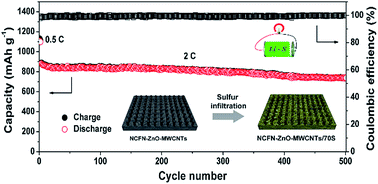Metal oxide nanoprism-arrays assembled in N-doped carbon foamy nanoplates that have efficient polysulfide-retention for ultralong-cycle-life lithium–sulfur batteries†
Abstract
The design and scalable construction of unique ordered structures, which can ensure efficient polysulfide-retention for ultralong-cycle-life lithium–sulfur (Li–S) batteries, are desirable but challenging for high-performance Li–S batteries. Herein, we demonstrate a novel ordered structure based on ZnO nanoprism-arrays (ZnO NAs) in N-doped carbon foam nanoplates (NCFNs) threaded with multi-walled carbon nanotubes (MWCNTs) and its facile construction to successfully address the above-mentioned challenges. The as-designed ordered architectures can not only load a high content of sulfur (90 wt% for NCFN–MWCNTs), but also suppress polysulfide dissolution via the synergistic effect of the ZnO NAs and NCFNs. Specifically, the electrode based on NCFN–ZnO–MWCNTs with a 70 wt% loading of sulfur delivers an initial specific discharge capacity of 1249.4 mA h g−1 at a 0.5C rate and shows exceptional reversible capacities of 1026.7, 887.5 and 698.6 mA h g−1 at 1, 2 and 5C rates, respectively. Moreover, the electrode exhibits an ultra-low capacity fade rate of 0.032% per cycle during 500 cycles with an average coulombic efficiency of over 99% at a 2C rate. We believe that this rational design of cathodes with unique ordered architectures and their scalable construction can provide an invaluable insight in the development of high-performance Li–S batteries for practical applications.



 Please wait while we load your content...
Please wait while we load your content...